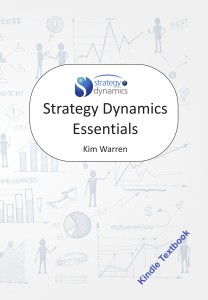Kim Warren on Strategy
Strategy insights and living business models
Kim Warren, business strategy and strategy dynamics expert
Kim spent 10 years in senior strategy roles before obtaining an MBA and PhD from London Business School (LBS). He taught strategic management at LBS for 20 years before leaving to focus on Strategy Dynamics.
Kim's story
After 10 years in senior strategy roles, including Retail Strategy Director at Whitbread PLC, I taught Strategic Management at London Business School for 20 years. I got frustrated with the simple, static strategy tools I was asked to teach. Few people use them in any case, because of their limited value. They basically help choose "where to compete" - what products/services to offer, to what target market?
roles, including Retail Strategy Director at Whitbread PLC, I taught Strategic Management at London Business School for 20 years. I got frustrated with the simple, static strategy tools I was asked to teach. Few people use them in any case, because of their limited value. They basically help choose "where to compete" - what products/services to offer, to what target market?
If that's all there is to "strategy", we do it very rarely indeed. (Winners like IKEA, Starbucks or Netflix have done basically the same thing for years, even decades!) But that can't be right - strategic management is a continuous, ever-changing challenge.
What leaders need is a method to help design the business system so that it could take that opportunity, and then manage the system so that it actually does take the opportunity - while all the time the market environment, and the business itself, are continually changing.
Luckily, I friends showed me the science of "system dynamics", which treats any social, economic, environmental or physical system (including any business) as a working system of interacting parts. It then applies rock-solid engineering principles to the design and management of that system. It was exactly what strategy needed, but was at the time presented in rather technical terms. So I translated the method's principles into managerial language and developed a reliable 4-step process to deploy it for any challenge, initiative or plan.
The resulting Strategy Dynamics method captures and quantifies how the elements in a business system interact and perform. It is able to produce a "digital twin" of any such challenge, initiative or plan that mimics - with uncanny realism - not only how performance outcomes change over time, but how everything that drives those outcomes also changes. When I show this to people, the first reaction is often "I never imagined this could be possible". Bit it is and not even especially complex or 'big'.
Armed with such a digital twin model, management can play out how the plan or issue may perform into the future, under a range of scenarios. And they can test alternative strategies to drive sustained improvements to future performance, whether that concerns fixing poor service quality, launching a new product, or even making a fundamental change to those "where to compete" choices. At the highest level, a strategy dynamics model is the strategy that will deliver the sustained growth in free cash flow that investors and other stakeholders ultimately care about.
The method also provides a sound basis for strategy development in public-service and non-commercial organisations.
My first book, Competitive Strategy Dynamics : Wiley, July 2002 won the 2005 Jay Wright Forrester Award from the International System Dynamics Society (I was 2013 President), but has now been superseded by Strategic Management Dynamics : Wiley, 2007. The e-book Strategy Dynamics Essentials provides a simple, practical guide to the method.
With my wife and amazing partner Christina Spencer, we have also developed a wide variety of learning materials that exploit the rigour, practicality and reliability of the Strategy Dynamics method. Our courses provide an encyclopaedic path for analysts or consultants who want to build these dynamic business models. And we have courses for senior leaders who want to know how to use those models (just as leaders already use spreadsheet models built by their staff or advisors). All this is enabled by the amazing Silico online modelling app - the easiest and most accessible software of its kind, designed specifically to support our 4-step process for building digital twin business models.

